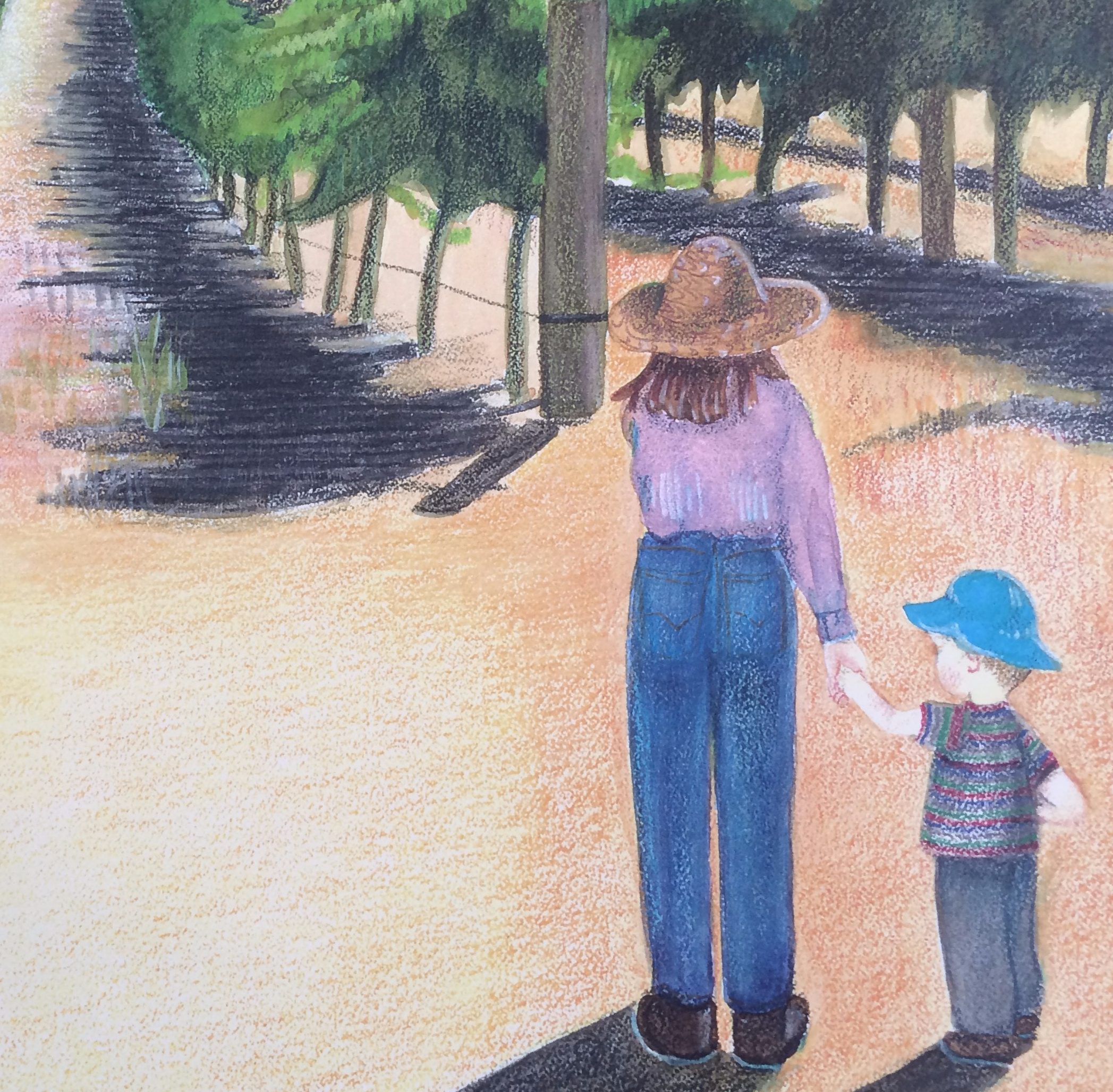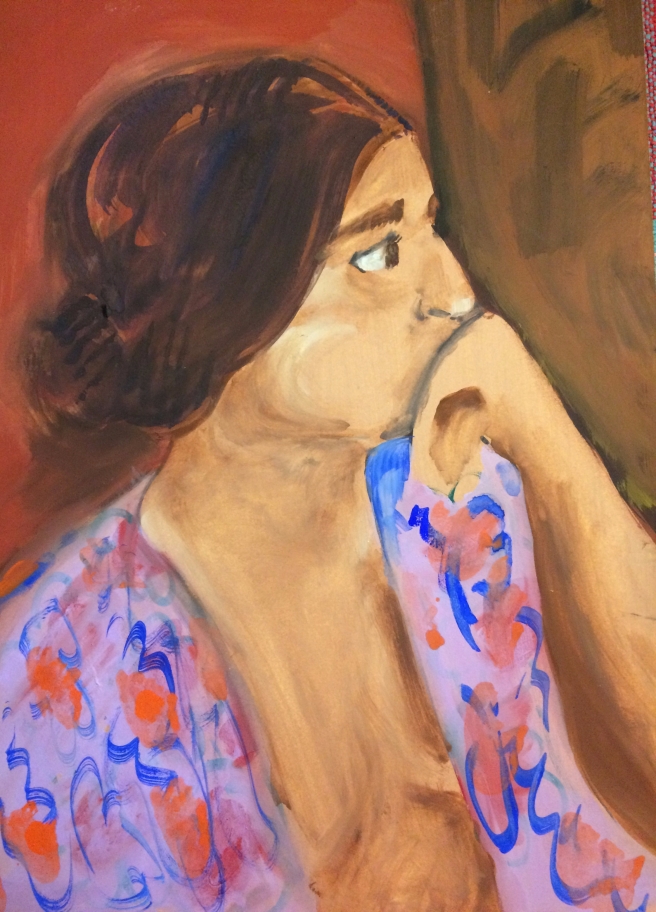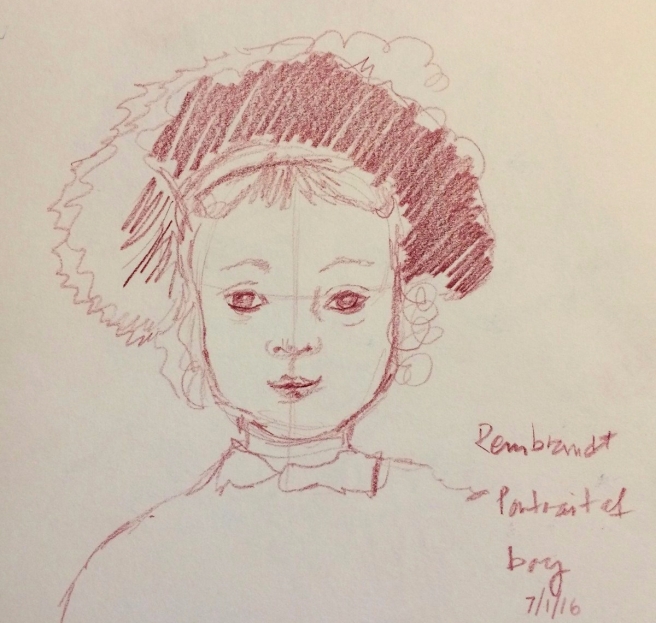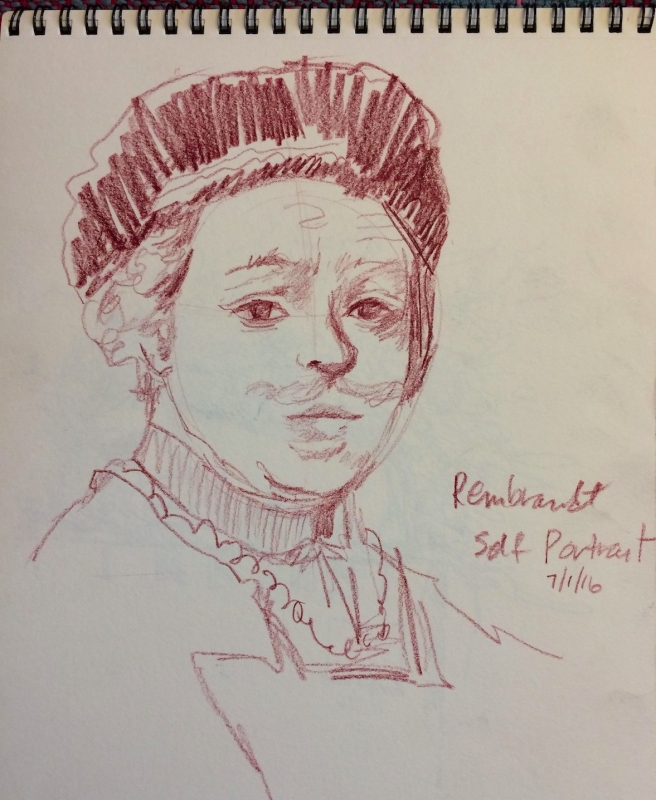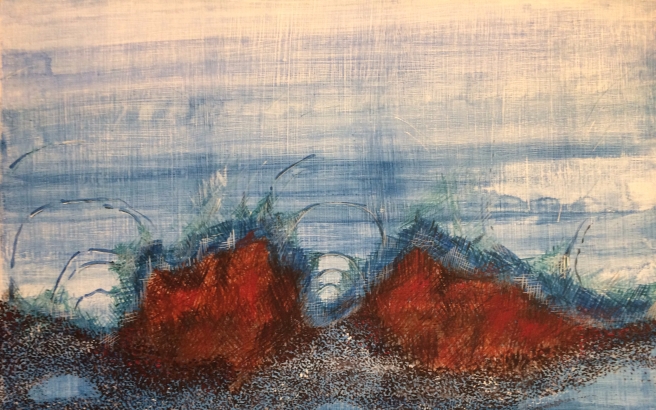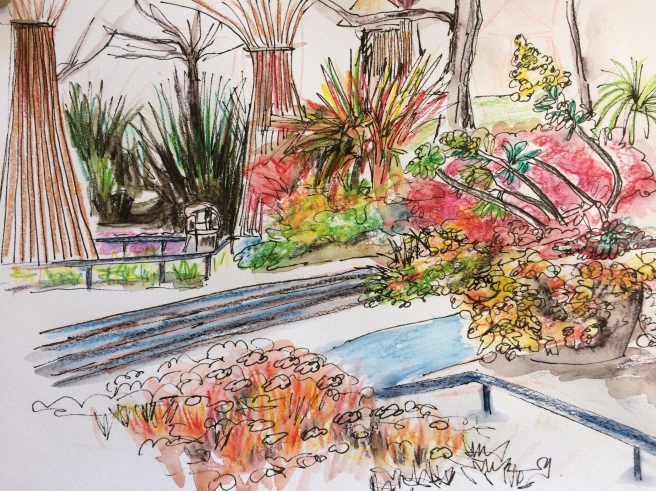
I had the flu last week, so I didn’t post any art or words. Did you miss me?
Last Sunday morning my sketching group went to the Getty Center here in LA. I know some people think LA is some kind of cultural wasteland, and maybe it is for some things. But The Getty is a Cultural Land and sketching there the other day was mostly great. The Getty Center sits atop a hill to the west of the 405 and the views from up there are astonishing. From the east side of the building you see rolling green hills and houses with a far off view of downtown Los Angeles. And to the west side of the building is quite an uninterrupted view of the Pacific Ocean. Even though I have lived in LA for a couple years now, this was only my second visit. The last time I was there it was quite warm, compared to the cold and ultimately rainy day I experienced on Sunday. It’s advertised to be free, but that’s a bit of LA hilarity in that you have to pay to park, and that comes out to be at least 15 dollars. And if you plan to eat in any of the eating-places there, it won’t be cheap. The parking structure is pretty massive, and it’s best to get there when it opens or you will get stuck in a massive traffic jam just to find a parking space—another bit of LA hilarity. Then you can take a tram to the top. If the weather is nice, you can walk up the hill, but most people ride the tram, and that can be mobbed as well.
I got to the top before the museum opened and the sun was out, but it was windy. It has been pretty wet here lately, so I was delighted to see the sun even if a cool wind was blowing all around. The sketchers all gathered in the lobby of the museum at 10 and we discussed what time we would get back together to share our artwork. Then we all shot off to parts we wanted to see. The last time I was there I had remembered an amazing garden at the base of The Getty and immediately hiked down there. By the time I settled in the spot looking at the colorful succulents you see here, there were already 3 or 5 of my artist brethren setting up and painting near me. My “sometimes chair” has not been in the back of my car for sometime now. So I have gotten used to looking for benches or chairs or even a perfect spot on the ground where I can sit on a sheet of bubble wrap. I left my first “sometimes chair” some place, sometime back. My second “sometimes chair” is at my son’s apartment in Santa Cruz. Not really sure why it’s there…But, luckily I found a chair under an amazing rebar bougainvillea planter—you can see a couple of them in the background of the garden view I sketched here. I didn’t take my watercolors with me for this visit, just colored pencils, black ink pens and my set of 14 or so Inktense pencils. I went to work making an initial thumbnail sketch and then started to work with the ink and my brightest Inktense colors, planning to add water when I got home. I amused myself with the idea that all I had to do was add water, kind of like I was making soup or something. As it got colder and the clouds gathered overhead, I toyed with the idea that I might just let it sit out in the imminent rain, and let nature take its course.
Right off the bat I was having trouble focusing on this little succulent vignette as various small groups of people passed in and out of my view. But after a time a bit more LA hilarity came my way. A woman, giving some kind of tour to a large group of visitors, told me that I wouldn’t mind if her larger group blocked my view for a short time, right? Actually, she didn’t really even look at me when she didn’t ask my permission to stand there. OK, this is what makes LA kind of infuriating at times–quite often, people around here don’t notice anyone but themselves and their immediate needs. I was a bit annoyed, but realized she was probably the kind of person who did the same thing when zooming down the freeway at 85 miles per hour. I was glad she wasn’t in my car with her trying to pass a couple trucks and me in the pouring rain on the 405. Finally, she was done talking and without a word to me, they all went on to annoy someone else. I thought it interesting that a person pushing someone else in a wheelchair said they were sorry they’d gotten in my way. At least that was nice. In my mind I was a bit behind because of all these interruptions and it was getting colder, and the once blue sky was now covered with grey clouds. Pretty soon it was raining again, and I was in no mood to let this sketch sit in the rain to see what would happen. By then I had also lost focus of what I was doing and thought I would head into one of the galleries and do some sketching in a warmer place.
But as I started up the hill I noticed there were way more people wandering around than when I had first arrived. Large posters were all around the Getty describing a featured painter named Jacopo da Pontormo. One of the other sketchers said that his piece called the Visitation should not be missed. I wandered into that gallery, hoping that I could focus on something else inside. But there were way too many people also trying to get a look at this painting, and I could not find a reasonably uninterrupted viewing spot to look at his Pontormo’s vision of the Virgin Mary chatting with Elizabeth. So, now I was wandering aimlessly from room to room, looking for a place and piece of art to draw. I ran into the same sketcher who had told me of The Visitation painting and we wandered out of that building and into another building that had some amazing Greek/Roman statues. Of course she had a little fold up chair to sit in and she settled herself right in front of a lovely statue. I finally found a bench next to a busy restroom and just outside the room of statues. I finished up my sketching at the Getty peaking into that room at the backside of a couple life-size statues. I was feeling pretty disappointed with what I had done for the day. Maybe I was still feeling a bit under the weather because of the flu or maybe I was tired of dealing with the weather and too much LA hilarity. Finally, it was time to meet and share what we had created. We all gathered together and had our usual “throw down,” but this is the first time I did not participate. I’ve never done that before. Usually I have some kind of sketch I’m OK with, but not that day. I participated in the group picture, but I wasn’t holding anything in my hands as the majority of other sketchers. Little did I know that lunch at the Getty with a few painters would be what I really needed that day. And little did I know that this piece would look OK when I finally added some water the next day at home.
So after that agonizing 30 minutes was over, some went back into the galleries and sketched some more, but some of us had lunch. I was hungry and needed some carbs, and we went to the café on the lower level. The food was not cheap or memorable, but the company of artists was a delectable main course that fed my artist’s soul. We sat and talked and shared all kinds of stories. One sketcher had just come back from China and he showed photos of the terra cotta armies he had seen there. Now, I had heard of the afterlife armies that had been part of an early emperor’s tomb, but he was so excited about what he had seen I enjoyed thinking again about these amazing creations with fresh and new eyes and ears. I said I was envious of artists/artisans of that day who were so focused on their work, with no distractions. For those focused few there were no people getting in their way, wandering aimlessly around. Just look at the meticulous work and beautiful things they made with no distractions. They got up in the morning and knew exactly what they were going to do.
The rest of lunch and our conversation was equally nourishing. One of our group member’s talked about how he struggled to relax, and had a hard time dealing with the waves of energy that seemed to take over. He said he thought he must be hyperactive or something. He shared an app that he was using to meditate and I was wondering if that would be good for me when I get into a crazy sketching/painting moment. Unlike him, painting and/or sketching is not meditative for me. I get a buzz when I am painting, and my body all but vibrates head to toe when I’m working. And then of course the conversation took a turn to the silly side and we laughed at the idea that maybe a poor “focused” maker of terra cotta army men might wake up each morning and think, WTF, I have to make another one of those ridiculous statues. As I packed my bag and said goodbye to my friends I realized how wonderful it is to be in the world with others who understand you, or at least appreciate a different way of looking at the world. Another bit of LA hilarity? I think not. These are definitely words and people to live by.
A final bit of LA hilarity?
The Academy Awards are this Sunday and will be held right here in LA—at the Dolby Theater. As I was listening to the traffic report on the way home from work on Friday, they were reminding drivers to avoid certain areas of LA near the theater as various streets near the theater were going to be closed off for Sunday night’s event. Yes, traffic is part of a way of life around here, not sure there is anything hilarious about that. Do I care about the Oscars? I rarely go to that part of LA, and rarely see any of the movies that are nominated. I did see Roma this year. What a lovely movie…
